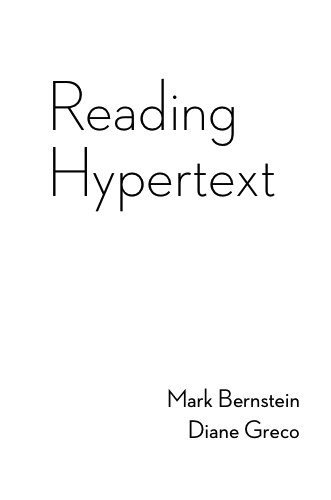Electracy
Stacey Mason
Exploring the idea of students learning by creating hypertexts, I asked my former professor Greg Ulmer how he came up with the idea of the assignment that he calls the “learning screen” in which students collaborate to understand hypertexts and then create a website to share their ideas. He explained:
The learning screen is for networked classrooms what the research paper is for book classrooms. The context of my pedagogy is my research goal of helping to invent “electracy.” Electracy is to digital technology what literacy is to alphabetic technology: an apparatus that includes not only equipment but institution formation and related practices, and identity experience, individual and collective. The methodologies used in the research paper were invented by the Classical Greeks, as part of their creation of a new institution, school. Plato’s Academy is the first school as we know it. Rhetoric, logic, poetics came into being in the context of figuring out what to do with writing. The equivalent today is to figure out what to do with hypermedia. In fact, the practices of electracy are being invented within Entertainment as an institution. We are in a period of transition, from one apparatus to another.
The challenge for school is how to bootstrap into electracy, what sort of relation we are going to have with Entertainment. Hopefully it will be more productive than was the long struggle between religion and science (science being the practice created within school and the alphabetic apparatus in general). When students come to my class they are familiar with both School and Entertainment. They have internalized both the skillset of literacy and the attitude of electracy. The difficulty is that the skillset of electracy has not yet been developed, neither at the level of equipment nor of logic. The learning screen is an assignment in the spirit of bootstrapping, transitional towards electracy.
I developed a method of invention called “heuretics,” a term that is in the O.E.D. but listed as “obsolete” or “rare.” It is derived from the same root as “Eureka” and “heuristics,” and is paired with “hermeneutics.” “Hermeneutics” is the use of theory to interpret existing works. “Heuretics” is the use of theory to invent new forms and practices. One of the heuristic devices of heuretics is to invent by contrast. The research paper is the Contrast for my pedagogy.
The character of our hypermedia practice is already outlined in principle as the opposite of the research paper. The very name of the pedagogy is generated in this way. We do not do “research,” but still “learn.” We work not with “paper” but “screen.” This way of generating the practice continues by noting some of the key features of a “paper,” listed in the handbooks used to teach literacy. “Papers” are supposed to be objective, third person, persuasive to others and the like. “Screens” are subjective, first person, persuasive to the author (reflexive). Part of the learning experience of the learning screen is due to the fact that students are familiar with the paper. Composing a learning screen should have the added value of making salient the differences between the two styles of education: learning screens are not better than research papers, but are specific to the apparatus of electracy.
So in order for students to exist in the world of hypertext, they must be able to not only read it, but write it as well. For this reason, many professors are assigning hypertext projects to students. Steve Ersinghaus writes,
At Tunxis Community College we do a lot with hypertext. At the moment we have two active courses, New Media Perspectives and Digital Narrative. Linking techniques are important to these courses and we use Tinderbox as the key tool. In NMP, student acquire basic understanding of Tinderbox and link techniques and aesthetics and in DN, they produce a more extensive project with the software. In both courses students read and study existing web hypertexts. In our New Media Communication program, students will use Tinderbox for note taking, project organization, and for producing complex hypertexts and spatial structures, with code manipulation and attribute play.
